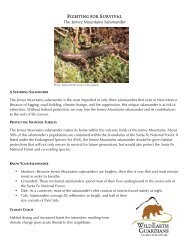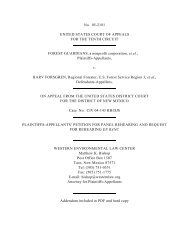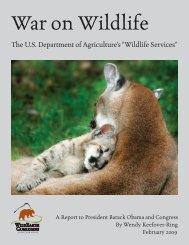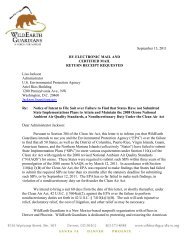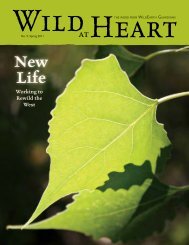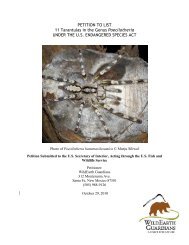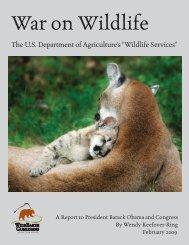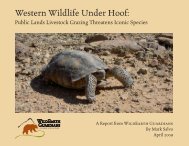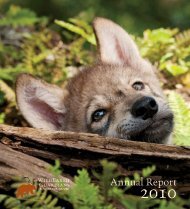PETITION TO LIST THE JEMEZ MOUNTAINS SALAMANDER ...
PETITION TO LIST THE JEMEZ MOUNTAINS SALAMANDER ...
PETITION TO LIST THE JEMEZ MOUNTAINS SALAMANDER ...
You also want an ePaper? Increase the reach of your titles
YUMPU automatically turns print PDFs into web optimized ePapers that Google loves.
WildEarth Guardians Petition to List<br />
Jemez Mountains Salamander Under the ESA<br />
25<br />
Table 3. Stand-replacing fires in Jemez Mountains salamander habitat. Sources:<br />
USFS 1996b; USFS 1996c; BAER 2000; USFS 2003c. Key: USNF = United States<br />
National Forest, BNM = Bandelier National Monument, LANL = Los Alamos National<br />
Laboratories, Pueblo land = Santa Clara and San Ildefonso.<br />
Fire Date Total Acreage High severity Moderate Low<br />
Dome<br />
Cerro<br />
Grande<br />
April-May<br />
1996<br />
May 2000<br />
(land owners)<br />
12,000 (USNF)<br />
4,500 (BNM)<br />
Total = 16,500<br />
(includes no burn<br />
areas)<br />
6,927 (Pueblo land)<br />
25,601 (USNF)<br />
828 (BNM)<br />
7,402 (LANL)<br />
Total = 42,878<br />
severity severity<br />
3,165 ac 3,490 ac 2,865 ac<br />
14,728 ac 3,578 ac 24,572 ac<br />
BMG/Lakes June/August 4,641 (USNF) 890 ac unknown unknown<br />
2002<br />
Totals 64,019 18,783 unknown unknown<br />
Fire suppression and rehabilitation activities in Jemez Mountains salamander habitat<br />
resulted in habitat degradation (BAER 2000). The BAER’s 2000 report notes:<br />
Effect of fire suppression: Jemez Mountains salamanders require a specific set of<br />
subterranean and terrestrial microhabitat conditions for activity. The microhabitat<br />
must be moist enough for cutaneous respiration. The soils and the rock structure<br />
must be friable enough to allow for movement deep into the soil column to escape<br />
high surface temperatures and low humidity. The habitat must be variable enough<br />
to support an abundant invertebrate prey base. Impacts of the following fire<br />
suppression activities may negatively affect the microhabitat suitability:<br />
• Potential release of contaminants from fire retardant<br />
• Development of hand lines and bulldozer lines for fire containment<br />
• Mop up of smoldering logs and stumps that may be potential postfire<br />
habitat for salamanders and their prey<br />
• Burn out operations that further eliminate vegetation and degrade<br />
habitat<br />
Effect of rehabilitation actions: Certain actions that may be taken to restore the<br />
habitat to pre-fire conditions and prevent the loss to life and property may have<br />
adverse effects on Jemez Mountains salamander populations and their ability to<br />
recolonize impacted areas. Such actions may include:<br />
• Reseeding of fibrous-rooted, non-native grasses<br />
• Use of heavy equipment to restore fire lines and roads<br />
• Road construction and culvert installation to prevent flooding



